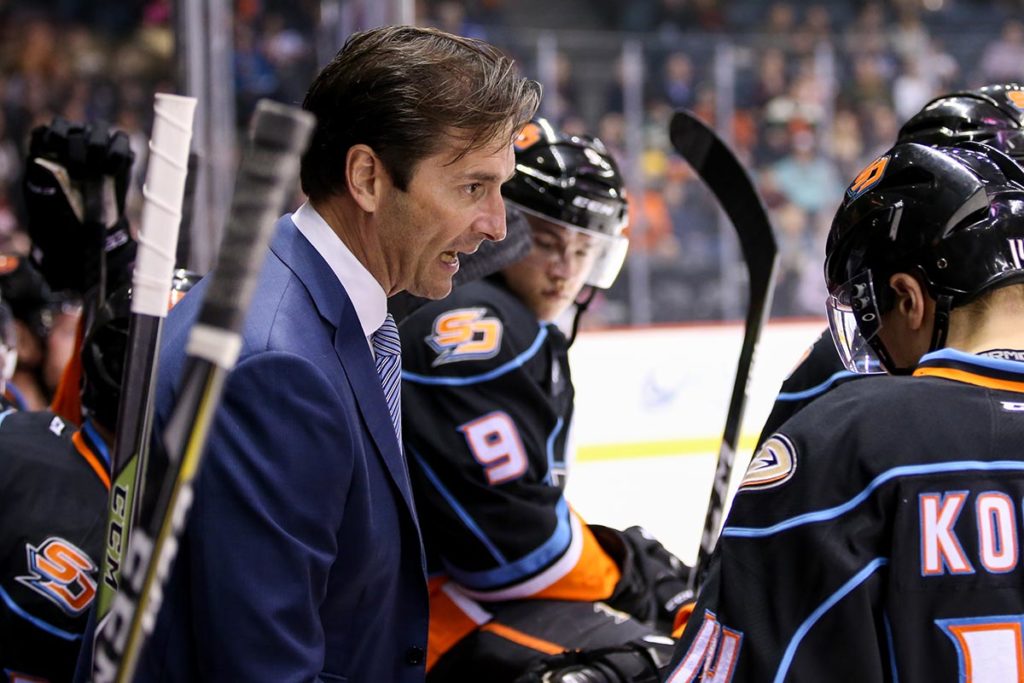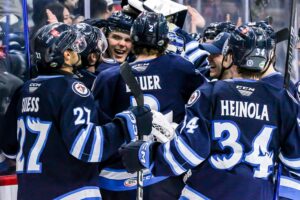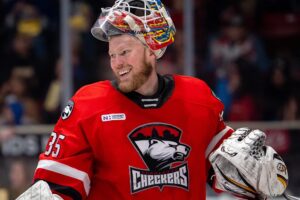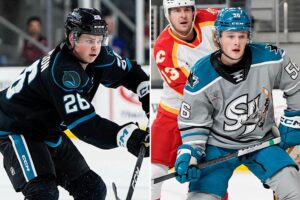by Craig Elsten | AHL On The Beat
San Diego Gulls head coach Dallas Eakins teaches a simple philosophy when it comes to the grind of the American Hockey League.
“I am a firm believer if you just look after today, then the standings, the games, all those things look after themselves,” said Eakins after a recent Gulls practice. “We’re going to stick with that. We’re going to be our best today, and a number of those days add up to a great season.”
Eakins’ simple and elegant plan, one which has led to playoff series wins in each of the first two seasons for the Gulls, has been tested throughout the course of the 2017-18 campaign by injuries, call-ups and a reliance upon untested skaters.
At the midway point of the season, San Diego’s 19 wins are the most through the first 34 games in club history and its 39 points are only one shy of the 40 points earned in 2016-17 (18-12-2-2). The Gulls find themselves in a familiar position, rising from a mediocre start into a spot vying for playoff position. While the ultimate position appears promising, how San Diego arrived at their current destination is more complicated than their previous two years.
“It’s been an up and down season so far, with our own injuries and injuries to the Ducks,” admitted Eakins. “We’ve had lots of movement between the two teams early on, which leads to a fair amount of instability.”
From every level of the ice, the Gulls were drained during their first 20 games. In net, intended starter Reto Berra spent the first two months of the season in the NHL backing up John Gibson in Anaheim, and was not initially assigned to San Diego until Nov. 24. Defenseman Jaycob Megna, San Diego’s franchise leader in games played (145) rightfully earned a spot on the Ducks roster out of camp, but as the team got healthier Megna was a casualty of numbers and joined the Gulls on Dec. 11. Forwards Kevin Roy (25 NHL games), Kalle Kossila(10 NHL games), and Dennis Rasmussen (27 NHL games) all spent significant time away from the Gulls, with the latter being assigned to San Diego at the end of December. .
In addition, top wingers Corey Tropp (15 games, lower-body injury) and Nic Kerdiles (16 games, upper-body injury) both missed significant time. As a result, the Gulls had the most combined rookie games played in the Pacific Division through the first two-plus months of the season.
“We went through some lows in November (3-7-0-0) and early on in the year, but I think that was good for our team,” said veteran center Sam Carrick, one of the few constants in the Gulls lineup through the first half. “We kind of came together as a team there.”
After a 7-10-1-0 start, the Gulls have risen in the rankings. San Diego is 13-6-0-0 since Dec. 1, including a stretch of five straight wins from Dec. 9-23. The team is healthier, the Ducks are back to nearly full strength, and the result is a forward group loaded with talent and leadership, along with newfound depth at every level of the ice.
“We were scraping for players (in November), and now we’ve got a lot of guys out of the lineup who are healthy scratches,” noted Eakins. “We are healthy, and that’s a good thing. It sets up for great competition and that’s what we’re all about here.”
One constant throughout the tumult has been the San Diego power play, which continues to rank at the top of the AHL. The Gulls lead the league with 45 power play goals and a 26.3% conversion rate. This, despite changing the personnel of their top unit repeatedly throughout the year, seeing their initial quarterback traded in early December (Spencer Abbott), and their blue line power play leader Andy Welinski promoted to the NHL for a span of six Gulls games.
“We’ve been keeping it pretty basic and executing on plays,” said Welinski, who was named to the AHL All-Star Game partly thanks to 18 power-play assists. “We’ve had a lot of power-play goals that are 10 or 15 seconds into power plays, and it’s a lot of fun to see that.”
“I think we all know our roles on the power play,” said Kalle Kossila, who led the Gulls in scoring at the halfway point (9-20=29 points in 23 games). “The breakouts have been working, good puck retrievals. Keep it simple, get the puck to the net and the guys in front of the net have been doing a great job.”
Overall, improvement in special teams has mirrored the Gulls’ rise back into competitive balance. After ranking at the bottom of the league for much of the first three months of the season in penalty killing, San Diego used a stretch where they killed 37-of-40 penalties to turn their potent power play into a true advantage.
“It’s a team effort,” said second year defenseman Keaton Thompson on the penalty kill. “We’re committed to blocking shots, and to getting the puck down 200 feet and making teams come at us.”
Not to be diminished are the contributions of veteransEric Fehr and Ryan White, who arrived in mid-November when the Gulls were at their lowest ebb. Fehr, 32, on loan from the Toronto Maple Leafs organization, has led San Diego with 11 goals since making his presence felt upon arrival with a two goal-game on November 17 against Tucson. White, 27, on a professional tryout contract, has provided heart, hustle and muscle, adding 7 points (2G/5A) and 47 PIM in 16 games.
“I like to keep my head on a swivel and watch what’s going on pretty closely,” said Fehr of his role as a veteran leader on the club. “I’ll definitely approach guys and talk to them, and pick their brain too. It’s interesting to me to talk to some of the younger guys and find out what they’re thinking.”
“We’ve got some really great veteran leadership, guys who have a ton of experience, especially at the NHL level, and we’ve got some young, hungry rookies who are trying to find their way through pro hockey,” added Eakins. “I think it’s an excellent mix, not only to put wins on the board, but a really good mix as well for our young players, as they benefit from our veterans’ presence.”
Heading into the All-Star break and the season’s unofficial second half, the Gulls find themselves in the most competitive division in the league. As of Jan. 20, all eight teams in the Pacific Division have a points percentage of .528 or above. A few games ago, San Diego was a win away from taking the top spot on the table, but a 1-3 stretch find the team mere percentage points outside the top four playoff positions.
One reason to be optimistic of a strong push during the tail end of the season is the Gulls’ track record. The Gulls have had strong second halves of the regular season dating back to January of the 2015-16 season. San Diego leads the Western Conference and ranks second among AHL clubs with the highest second half win percentage (.711%), and is tied for second in the AHL in second half wins (48) in that span. San Diego also has the fewest second half losses (18) among all 30 clubs.
As Eakins says, the Gulls will focus on the present day and let the standings take care of themselves. The mantra has sunk into the room, where veteran leadership repeats and reinforces the approach.
“I don’t think we focus too much on who we are playing. We prefer to focus on our style of game,” said Carrick. “We think if we play our style, it doesn’t matter who we are playing, we’ll have a chance to win.
“I think it’s important to set goals for your team, and we want to win every night, no matter what. If we take the approach of not looking at who we’re playing next weekend, or in three weeks, we want to win tonight. If we focus on getting the two points every night, good things will happen.”
Sound familiar?
“Everything is about compete,” said Eakins. “Whether it’s with yourself, or with your teammates, or with the other team. We like the state we’re in right now, and we’re starting to see the benefits of having a healthy and competitive group.”






































